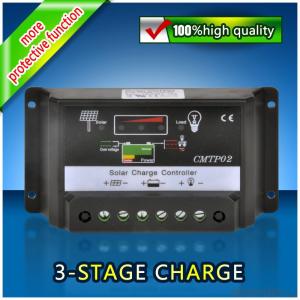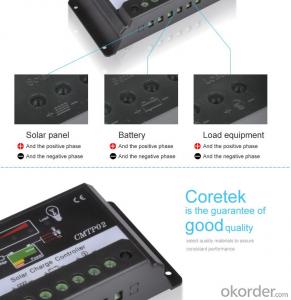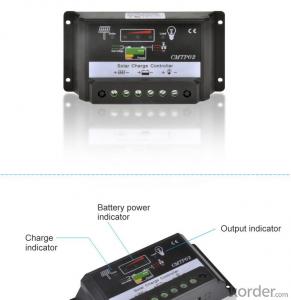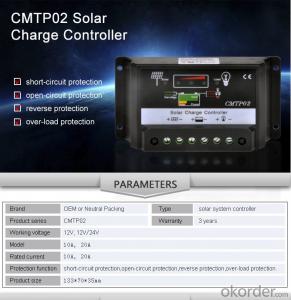Plug-and-play Solar Controller CMTP02 with very good price
- Loading Port:
- China main port
- Payment Terms:
- TT or LC
- Min Order Qty:
- 1 unit
- Supply Capability:
- 10000 unit/month
OKorder Service Pledge
OKorder Financial Service
You Might Also Like
Product Introduction
Solar controller is control device which can control solar panel and transform solar energy into electricity then store to the battery bank. Solar controller is the most important part in offgrid system, whose performance has much effect on life expectancy and operation of the whole system, especially the battery expectancy.
Application Areas
Standalone Photovoltaic power station
Standalone Domestic household photovoltaic power system
Mobil communication base stations, expressway and other non-residential regions.
Coastal islands, remote mountainous, border posts for regions shortage of or without electricity.
Government demonstration projects, landscape lighting project etc.
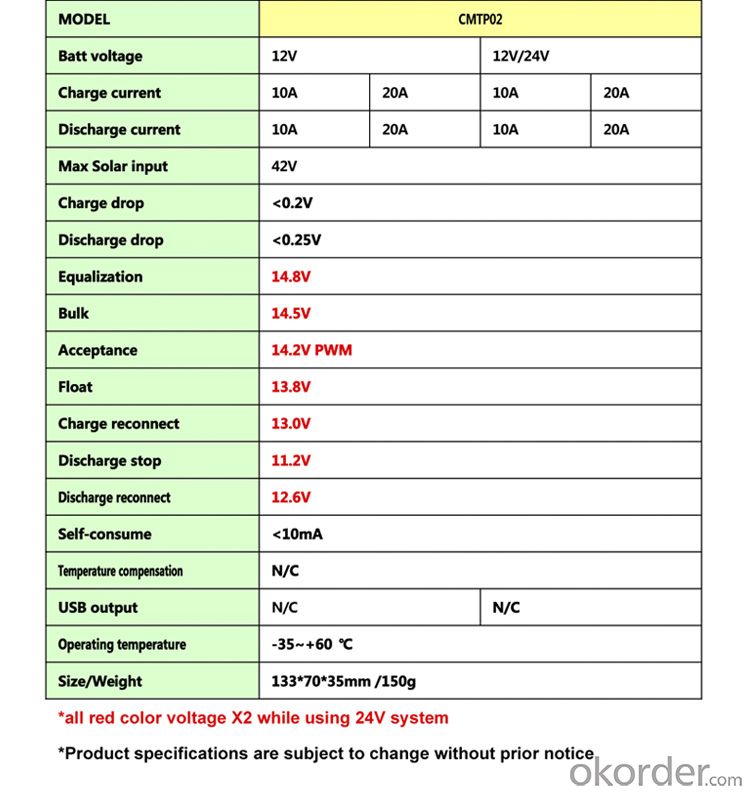
Selection of high-quality materials properties be consistent from beginning to end
For life is a convenient
A little more secure
The innovation design idea of the perfect show
The first set of people-oriented
The high-end configuration components
- Q:What is the maximum number of load control modes supported by a solar controller?
- The maximum number of load control modes supported by a solar controller can vary depending on the specific model and manufacturer. However, most solar controllers typically support around 4 to 5 load control modes, allowing users to customize and optimize their energy usage according to their specific needs and preferences.
- Q:How do you prevent reverse current flow with a solar controller?
- A solar controller prevents reverse current flow by utilizing a diode in its circuitry. This diode allows current to flow from the solar panels to the battery, but blocks the flow of current in the opposite direction, thus preventing reverse current flow.
- Q:Can a solar controller handle low light conditions?
- Yes, a solar controller can handle low light conditions. Solar controllers are designed to regulate the flow of electricity from solar panels to batteries, and they have the ability to adapt to varying light conditions. They can adjust the charging parameters to optimize the energy conversion even in low light situations, ensuring efficient power generation and storage.
- Q:Can a solar controller be used in a solar-powered ventilation system?
- Yes, a solar controller can be used in a solar-powered ventilation system. A solar controller helps regulate and optimize the charging and discharging of the battery in a solar system, ensuring the ventilation system operates efficiently. It helps monitor the solar panel's output and adjusts the power flow to the ventilation system accordingly.
- Q:How does a solar controller handle load control and diversion charging?
- Load control and diversion charging are managed by a solar controller, which utilizes its built-in features and capabilities. To control the load, the controller offers multiple load terminals or outputs that can be connected to various electrical loads. This allows the controller to regulate the power flow and manage the energy consumption of each load, preventing system overload and ensuring efficient use of solar power. On the other hand, diversion charging involves redirecting surplus energy generated by the solar panels to charge additional devices or batteries. This is achieved by connecting a diversion load, such as a dump load or secondary battery bank, to the solar controller. When the connected loads require less energy than what is being produced, the excess power is diverted to the diversion load, preventing overcharging of batteries and maximizing solar energy utilization. Sophisticated algorithms and monitoring systems are commonly employed by solar controllers to determine when to activate load control or diversion charging. These algorithms take factors like battery voltage, solar panel output, and load requirements into consideration to make intelligent decisions regarding power distribution and diversion. Some controllers even utilize advanced MPPT technology to optimize solar panel output and ensure efficient power conversion. In conclusion, a solar controller effectively manages load control and diversion charging by providing multiple load terminals for power distribution and redirecting excess energy to a diversion load. It utilizes algorithms and monitoring systems to make intelligent decisions and optimize the utilization of solar energy.
- Q:Can a solar controller be used in a solar-powered marine system?
- Yes, a solar controller can be used in a solar-powered marine system. A solar controller regulates the voltage and current from the solar panels to ensure optimal charging of the batteries. It is a crucial component in any solar-powered system, including marine systems, as it helps protect the batteries from overcharging and maximizes their lifespan.
- Q:How does a solar controller handle battery voltage regulation?
- A solar controller handles battery voltage regulation by continuously monitoring the voltage of the battery bank and adjusting the charging current accordingly. It ensures that the battery voltage remains within the desired range by automatically reducing or increasing the charging current from the solar panels. This helps prevent overcharging or undercharging of the batteries, maximizing their lifespan and performance.
- Q:Can a solar controller be used with any type of solar panel?
- Yes, a solar controller can be used with any type of solar panel as long as the voltage and current specifications of the solar panel are within the range supported by the controller. The controller regulates the charging process and ensures optimal power transfer between the solar panel and the battery, regardless of the panel's technology or design.
- Q:How do I know if my solar controller is working properly?
- To determine if your solar controller is functioning properly, you can perform a few simple checks. Firstly, check if the controller's display is showing the expected information, such as battery voltage, charging status, or load settings. Secondly, verify that the controller is connected to the solar panels and battery system securely. You can also examine the controller for any physical damage or loose connections. Lastly, monitor if the controller is effectively regulating the charging and discharging of your batteries. If it appears to be correctly managing the power flow and maintaining the desired battery levels, then your solar controller is likely working properly.
- Q:How do I prevent overcharging of batteries with a solar controller?
- To avoid batteries being overcharged by a solar controller, there are several important measures you can take: 1. Select an appropriate solar controller: Ensure that the solar controller you choose is specifically designed to prevent overcharging. Look for controllers that have advanced features such as Maximum Power Point Tracking (MPPT) or Pulse Width Modulation (PWM) technology, as these can effectively regulate the charging process. 2. Adjust the charging parameters correctly: Most solar controllers allow you to customize the charging parameters, including voltage setpoints and charging modes. It is crucial to understand the recommended charging parameters for your specific type of battery and adjust the settings accordingly. Consult the battery manufacturer's specifications or seek professional advice to determine the appropriate settings for your battery. 3. Utilize temperature compensation: Batteries are sensitive to temperature changes, and the charging process should be adapted accordingly. Some solar controllers offer temperature compensation features that automatically adjust the charging voltage based on the battery's temperature. This feature is particularly useful in preventing overcharging during extreme weather conditions, such as hot summers or cold winters. 4. Install a battery temperature sensor: If your solar controller does not come with built-in temperature compensation, you can install a battery temperature sensor. This sensor measures the battery's temperature and relays the data to the solar controller, allowing it to adjust the charging parameters accordingly. 5. Regularly monitor the charging process: Keep a close eye on the charging status of your batteries. Many solar controllers come equipped with display screens or monitoring interfaces that provide real-time information about the charging process. Monitoring the voltage, current, and battery temperature will enable you to identify any potential issues and take corrective actions when necessary. 6. Implement a multi-stage charging process: Instead of consistently applying a high charging voltage, consider employing a multi-stage charging process. This involves initially providing a higher voltage to rapidly charge the battery, and then automatically switching to a lower voltage once the battery reaches a certain level. This method helps prevent overcharging and extends the lifespan of the battery. By following these steps and proactively monitoring and adjusting the charging process, you can effectively prevent batteries from being overcharged by a solar controller. This ensures optimal performance and longevity of your battery system.
1. Manufacturer Overview |
|
|---|---|
| Location | |
| Year Established | |
| Annual Output Value | |
| Main Markets | |
| Company Certifications | |
2. Manufacturer Certificates |
|
|---|---|
| a) Certification Name | |
| Range | |
| Reference | |
| Validity Period | |
3. Manufacturer Capability |
|
|---|---|
| a)Trade Capacity | |
| Nearest Port | |
| Export Percentage | |
| No.of Employees in Trade Department | |
| Language Spoken: | |
| b)Factory Information | |
| Factory Size: | |
| No. of Production Lines | |
| Contract Manufacturing | |
| Product Price Range | |
Send your message to us
Plug-and-play Solar Controller CMTP02 with very good price
- Loading Port:
- China main port
- Payment Terms:
- TT or LC
- Min Order Qty:
- 1 unit
- Supply Capability:
- 10000 unit/month
OKorder Service Pledge
OKorder Financial Service
Similar products
New products
Hot products
Hot Searches
Related keywords
